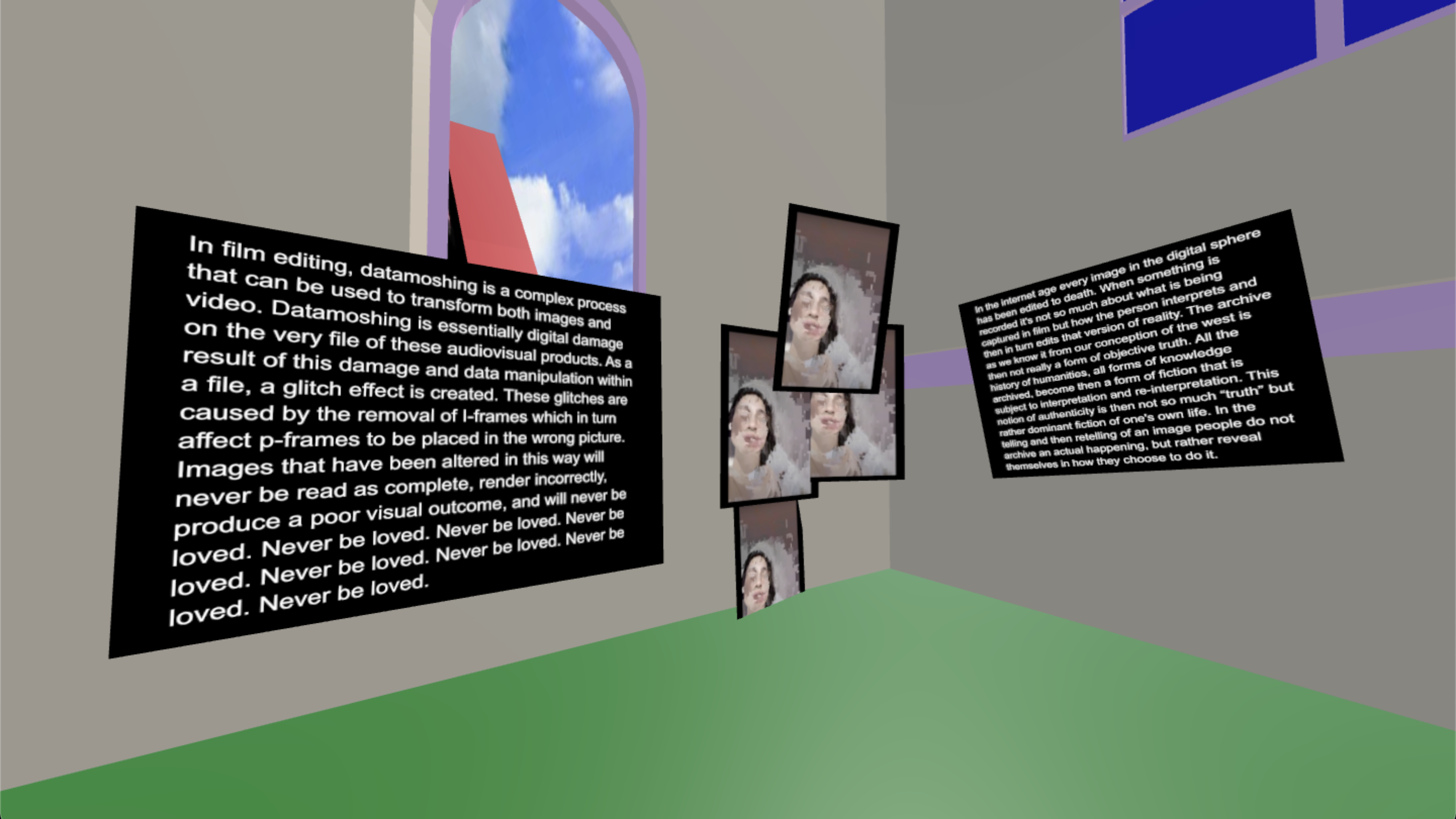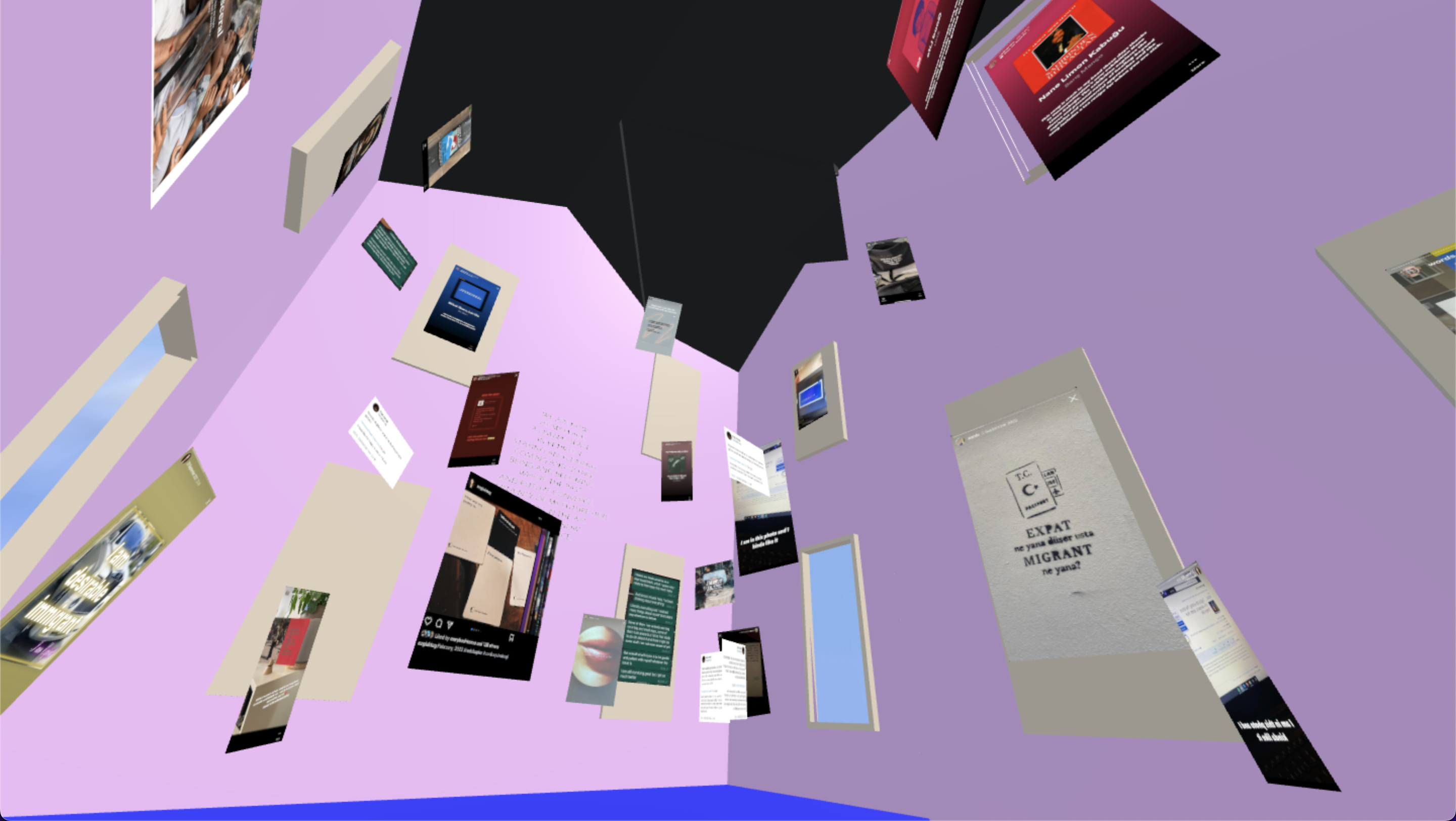Residents of Portal Park
Aking Minamahal na Error / My Beloved Error, Franko Mamaril

In realizing the phenomenon of how the internet is being a portal of disinformation and being abused by the state for skewed political agendas, Aking Minamahal na Error / My Beloved Error posts glitches caused by excessive human logging-in on the internet. Franco Mamaril offers a direct and abstract visualization of human activities in social media platforms and beyond: In his videos Notification glitch and Bungaga / Mouth, the artist highlights the internet users’ overwhelming flow of data and puts into question the accountability involved with reactions. Aking Minamahal na Glitch (Ingay) / My Beloved Glitch (Noise) illustrates a site-map wherein there is a section for safe space; leading to AUDIOREACTIVE GEOMETRIC GLITCH which is a graphic representation of what could be done in terms of content, considering the im/permanence of data and how it can be processed by the most innocent of users.
Entering Aking Minamahal na Error / My Beloved Error lets one think of how we partake in the internet world, and how it is not entirely dis/associated in the realities of the landscape we belong to. This space then invites the visitor to look beyond the moving images, so that when confronted with overpowering noise, Mamaril asks “how to look for some clarity?”
Franco Mamaril (1996 / San Pedro, Laguna) immerses himself in the off/on-line and the various relational/programming languages to create artworks as representations of his existence to these world/s. His artistic practice of exploring images involves transforming traditional media to generative images by applying experimental flows in simulating the effects created by design software.
In living and making off/on-line through these realities, Franco experiences a heightened expansion of his character and narrative-making; negotiations with acceptance of our humanness; and understanding the impacts of his participation in the internet-culture.
Fungi Memes, Ringailė Demšytė

Fungi facilitate communication and collaboration among trees and other life forms. Mycorrhizal fungi hyphae form an underground network that links plants together, allowing the transfer of minerals and nutrients between them. This phenomenon, discovered by Canadian scientist Suzanne Simard in 1990, is known as the Wood Wide Web. The relationship between plants and mycorrhizal fungi is key to understanding how ecosystems function.
Similarly, the internet facilitates communication between humans, allowing us to effortlessly share both humor and information, such as memes. Could we collaborate with fungi to co-author online content, conveying their wisdom through internet humor to seamlessly blend it into our culture? This could cultivate an elevated awareness of nature’s importance and our connection to it.
However, before this reality is possible, Ringaile delved into crafting speculative fungi memes herself by merging, picture random fungus, prompt ‘make a meme’, and added AI-generated fungi jokes, translated into her Visual Fungi Language.
Ringailė Demšytė (1998) is a Lithuanian visual artist who has been fascinated by fungi since a young age. Her parents affectionately called her “mushroom,” and her childhood was filled with fairytales and drawings cantered around mushrooms. Recently, as Ringailė paid tribute to her childhood and continued to explore the world of fungi through research-based projects, fungi became an inseparable and essential part of her artistic practice. Passionate about visual communication, Ringailė pushes the boundaries between reality and imagination, employing digital tools and printed mediums to challenge her artistic process. Furthermore, she delves into the realm of fictional languages and experimental soundscapes, using visual experimentation as a means of exploration.
Rebirth, Sabrina Lumer
Rebirth follows a short-film format in which a young woman (portrayed by Sabrina Lumer) finds herself challenged by the unattainable goals set on social media. Once it has become too much to bear, a moment of silence allows her to disconnect and enjoy life again. Create only to create, not to do it for views. Inspired by Black Mirror’s Nosedive (SE03, EP01), Rebirth similarly presents a positive ending depicting how societal pressures can influence an individual following a catharsis scene.
Introducing Sabrina (1997), a young creative from Rotterdam. After experimenting in various off- and online art forms, her work will now be exhibited for the first time during the virtual residency, ‘Welcome Back to Portal Park’. Growing up, she has always been involved in art and culture and as such is very grateful for the opportunity to create with her fellow residents.
Us, your pictures, and I, Marina Prada-Ramos

Marina Prada-Ramos (1999) is a Spanish-Uruguayan artist with a BA in fine arts and currently studying an MA in artistic research at University of Amsterdam. Her focus is usually on the performance practices and queer performativity but also she does research in contemporary digital visual cultures. She works with the body which at times happens to intersect with the internet.
The modern businesswoman, Famke Immelmann

One of the more serious criticisms against AI and algorithms is that it infers biases and reinforces stereotypes. If a dataset is not collected thoughtfully, the algorithm will be trained to reproduce results which are not thoughtful. In The modern businesswoman (2023), Famke uses AI tools to conjure up a series of generated images which represent the professional working woman. The result is a brave and sophisticated woman who delivers an important presentation to some corporate colleagues.”
Famke (1998) is a 3D designer who is interested in what contributions technology can make to fashion and broader society. She sees technology as a template for innovation and cooperation that can to some extent be liberating for creatives inside a destructive fashion system. Rather than following predictive patterns through risk management and forecasting, Famke works with ideas of temporality and change to welcome experimentation and the creation of a future that does not prolong the social ills of the present.
Portal Park Installation, Alexander Schmidt

For Portal Park, Alex compiled some of his recent works along with ones specially made for and influenced by his time in portal park into the video project “assorted works for portal park”.
During his residency, he also streamed his creative process into Portal Park. Exemplary are DJ Sets from his bedroom setup or livestreams of researching and editing the projects with live feeds from different cameras around his space.
This project, titled “resident of portal park”, existed to get lost even more into the feeling of being a resident of a virtual neighborhood and coworking space, exploring contemporary interpretations of concepts such as privacy and connectedness.
Alex (1998) is a young creative based between Düsseldorf and Cologne. As the filmer of his friend group, he likes to capture their skating adventures and edit them into explorative mixed media collages. Using old hardware such as analog and digital foto and video cameras, he embraces the unpredictable events that happen inside and outside of the camera. The works depict the weekends of the past months, and are often coupled with his experimental musical endeavors. His prime motivation is creating in a playful way, for the sake of creating and having fun as well as learning along the way.
Staff Only, Kexin Hong
What if the reality you perceive as virtual belongs to someone else?
What if your perception of reality is shaped by what you consider virtual?
Through an interactive digital display, Kexin switches the roles of subject and object, offering a third perspective on our reality shaped by vast data surveillance. She merges personal experiences and fiction in a multimedia short film. The story features a protagonist who loses her reflection in real life and projects her identity onto an online persona. This virtual character gradually becomes the protagonist’s new reality. Investigating from techno-philosophical and psychoanalytic angles, the narrative explores the power structures’ use of self-projection through big data and social media manipulation. Kexin guides viewers to rethink the boundaries between self and projection, reality and virtuality, prompting a reflection on these mirrored perspectives.
Kexin Hong (1998, China) is a multidisciplinary artist working with film, sculpture and digital fabrication to explore psychosocial and political forces in the digital realm. Kexin investigates the increasingly blurred lines between reality and virtuality, the real and the fictive, truth and post-truth, particularly in relation to the self and how it responds to bodies of power in the digital age. Kexin investigates the ways in which propaganda exploits a symbolic “Other” to achieve its political objectives, specifically in the context of the post-truth era and social media.
Have you seen Sir Valentijn, Tosca Valentijn Hamel

‘Have you seen Sir Valentijn’ is the result of Tosca’s personal research into the psyche of having an online Drag persona. How much is performance, how much is real? Are we the mask or the wearer?
To reclaim a balanced sense of self and view drag as an artistic practice again, Tosca has found it to actually be good etiquette to separate themselves from their Drag persona ‘Sir Valentijn’. They like to consider him a character they are in charge of writing.
Sir Valentijn now exists as a bouncy video game sprite in portal park, but might escape back to the offline realm any time.
Tosca Valentijn Hamel (1995) is a Drag performer and visual artist, who has always been very motivated by the sharing of work online. Whether that work is illustration, comics, videos or a carefully curated portfolio of their Drag performances, the thought has always been ‘How can I present this to an online audience?’.
As a child of the internet, Tosca is very aware that not only their art, but also their psyche and sense of self have been greatly influenced by being online since their formative years. It’s become hard to not let their online space define their identity.
An Unfinished Home, Ezgi Aktuğ

Step into “An Unfinished Home,” a virtual house that mirrors the visceral journey of a young migrant woman. This ongoing work brings monthly photo dumps, tweets, WhatsApp chats, Instagram stories and other forms of digital content together as part of a digital life writing project. Together, they explore the intricacies of urban existence, where the challenges of migration, labor, and mental health form the backdrop. Urban visuals combined with personal reflections create a vibrant portrayal of ordinary life, presenting an artistic interpretation that resonates with contemporary culture.
Just like this virtual home is incomplete, so is the story. The project embraces this incompleteness, reflecting the real struggle of pursuing personal aspirations amid daily life in the 21st century.
Drawing from a foundation in social sciences and humanities, and a versatile background in the cultural and educational sector, Ezgi’s (1996) artistic pursuit lies in the realms of A/R/Tography and autoethnographic storytelling. Grounded in an amateur ethos, Ezgi blends personal narratives with cultural insights to create an authentic and insightful exploration of the human experience.